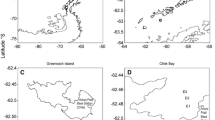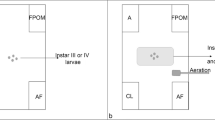Abstract
Feeding ecology was analysed for the first time in the larvae of the European hake (Merluccius merluccius) to determine whether their diet and selectivity were constrained by environmental conditions and how these feeding characteristics were related to ontogeny, prey availability and visual capabilities. Larvae collected during both day and night were analysed, and it was found that feeding incidence was high, regardless of the time of day. Examination of the visual system corroborated the hypothesis that hake larvae should be able to cope with a wide range of photic conditions and to forage even at low light intensity. A clear preference for adult calanoid copepods and, especially, for Clausocalanus spp. was observed in all sizes analysed. Prey number increased with larval size, but prey size did not. This finding indicates that hake larvae behave as selective and specialist predators that consume an increasing number of prey rather than larger prey during larval growth.







Similar content being viewed by others
References
Alheit J, Pitcher TJ (1995) Hake, fisheries, ecology and markets. Fish and fisheries series 15. Chapman & Hall, London, p 487
Arneri E, Morales-Nin B (2000) Aspects of the early life history of European hake from the central Adriatic. J Fish Biol 56:1368–1380
Bailey KM, Houde ED (1989) Predation on eggs and larvae of marine fishes and the recruitment problem. Adv Mar Biol 25:1–83
Bell JG, McEvoy LA, Estevez A, Shields RJ, Sargent JR (2003) Optimising lipid nutrition in first-feeding flatfish larvae. Aquaculture 227(1–4):211–220
Blaxter JHS (1986) Development of sense organs and behavior of teleost larvae with special reference to feeding and predator avoidance. Trans Am Fish Soc 115:98–114
Bozzano A, Recasens L, Sartor P (1997) Diet of the European hake Merluccius merluccius (Pisces: Merluciidae) in the western Mediterranean (Gulf of Lion). Sci Mar 61:1–8
Bozzano A, Pankhurst PM, Sabatés A (2007) Early development of eye and retina in lanternfish larvae. Vis Neurosci 24(3):423–436
Browman HI, Gordon WC, Evans BI, O’Brien WJ (1990) Correlation between histological and behavioral measures of visual acuity in a zooplanktivorous fish, the white crappie (Pomoxis annularis). Brain Behav Evol 35:85–97
Buskey EJ, Coulter C, Strom S (1993) Locomotory patterns of microzooplankton: potential effects on food selectivity of larval fish. Bull Mar Sci 53:29–43
Cartés JE, Hidalgo M, Papiol V, Massuti E, Moranta J (2009) Changes in the diet and feeding of the hake Merluccius merluccius at the shelf-break of the Balearic Islands: influence of the mesopelagic-boundary community. Deep Sea Res Part I Oceanogr Res Pap 56(3):344–365
Cass-Calay SL (2003) The feeding ecology of larval Pacific hake (Merluccius productus) in the California Current region: an updated approach using a combined OPC/MOCNESS to estimate prey biovolume. Fish Oceanogr 12:34–48
Catalán IA, Alemany F, Morillas A, Morales-Nin B (2007) Diet of larval albacore Thunnus alalunga (Bonnaterre, 1788) off Mallorca Island (NW Mediterranean). Sci Mar 71:347–354
Checkley DM (1982) Selective feeding by Atlantic herring (Clupea harengus) larvae on zooplankton in natural assemblages. Mar Ecol Prog Ser 9:245–253
Chesson J (1978) Measuring preference in selective predation. Ecol 59:211–215
de Ciechomski JD, Weiss G (1974) Estudios sobre la alimentación de larvas de la merluza, Merluccius merluccius hubbsi y de la anchoita, Engraulis anchoita en el mar. Physis Rev Asoc Argent Cienc Nat 33:199–208
Economou AN (1991) Food and feeding ecology of five gadoid larvae in the northern North Sea. ICES J Mar Sci 47:339–351
Fernald RD (1990) Teleost vision: seeing while growing. J Exp Zool Suppl 5:167–180
Fiksen O, Jorgensen C, Kristiansen T, Vikebo F, Huse G (2007) Linking behavioural ecology and oceanography: larval behaviour determines growth, mortality and dispersal. Mar Ecol Prog Ser 347:195–205
Fortier L, Harris RP (1989) Optimal foraging and density-dependent competition in marine fish larvae. Mar Ecol Prog Ser 51:19–33
Govoni JJ, Ortner PB, Al-Yamani F, Hill LC (1986) Selective feeding of spot, Leiostomus xanthurus, and Atlantic croaker, Micropogonias undulatus, larvae in the northern Gulf of Mexico. Mar Ecol Prog Ser 28:175–183
Hillgruber N, Kloppmann M (2001) Small-scale patterns in distribution and feeding of Atlantic mackerel (Scomber scombrus L.) larvae in the Celtic Sea with special regard to intra-cohort cannibalism. Helgoland Mar Res 55:135–149
Hunter JR (1981) Feeding, ecology and predation of marine fish larvae. In: Lasker R (ed) Marine fish larvae: morphology ecology and relation to fisheries. University of Washington Press, Seattle, pp 33–77
Huse I (1994) Feeding at different illumination levels in larvae of three marine teleost species: cod, Gadus morhua L., plaice, Pleuronectes platessa L., and turbot, Scophthalmus maximus L. Aquacult. Fish Manage 25:687–695
Kattner G, Hagen W (2009) Latitudinal characteristics and perspective to global warming. In: Arts MT, Brett MT, Kainz M (eds) Lipids in aquatic ecosystems. Springer, New York, pp 257–280
Land MF (1981) Optics and vision in invertebrates. In: Autrum H (ed) Handbook of sensory physiology, vol VU/6B. Springer Verlag, Berlin, pp 470–591
Land MF, Nilsson DE (2002) Animal eyes. Oxford University Press, Oxford, p 244
Laroche JL (1982) Trophic patterns among larvae of five species of sculpins (family: Cottidae) in a Maine estuary. Fish Bull 80:827–840
Last JM (1980) The food of twenty species of fish larvae in the west-central North Sea. Fish Res 60:1–44
Lechowicz MJ (1982) The sampling characteristics of electivity indices. Oecologia 52:22–30
MacKenzie BR, Miller TJ, Cyr S, Leggett WC (1994) Evidence for a dome-shaped relationship between turbulence and larval fish ingestion rates. Limnol Oceanogr 39:1790–1799
Maynou F, Lleonart J, Cartes JE (2003) Seasonal and spatial variability of hake (Merluccius merluccius, L.) recruitment in the NW Mediterranean. Fish Res 60:65–78
Mazzocchi MG, Paffenhöfer GA (1999) Swimming and feeding behaviour of the planktonic copepod Clausocalanus furcatus. J Plankton Res 21:1501–1518
McLaren IA, Avendaño P (1995) Prey field and diet of larval cod on Western Bank, Scotian Shelf. Can J Fish Aquat Sci 52:448–463
Morote E, Olivar MP, Pankhurst PM, Villate F, Uriarte I (2008a) Trophic ecology of bullet tuna Auxis rochei larvae and ontogeny of feeding-related organs. Mar Ecol Prog Ser 353:243–254
Morote E, Olivar MP, Villate F, Uriarte I (2008b) Diet of round sardinella, Sardinella aurita, larvae in relation to plankton availability in the NW Mediterranean. J Plankton Res 30:807–816
Morote E, Olivar MP, Villate F, Uriarte I (2010) A comparison of anchovy (Engraulis encrasicolus) and sardine (Sardina pilchardus) larvae feeding in the Northwest Mediterranean: influence of prey availability and ontogeny. ICES J Mar Sci 67:897–908
Olivar MP, Quílez G, Emelianov M (2003) Spatial and temporal distribution and abundance of European hake, Merluccius merluccius, eggs and larvae in the Catalan coast (NW Mediterranean). Fish Res 60:321–331
Olivar MP, Emelianov M, Villate F, Uriarte I, Maynou F, Alvarez I, Morote E (2010) The role of oceanographic conditions and plankton availability in larval fish assemblages off the Catalan coast (NW Mediterranean). Fish Oceanogr 19(3):209–229
Oliver P, Massutí E (1995) Biology and fisheries of western Mediterranean hake (M. Merluccius). In: Alheit J, Pitcher TJ (eds) Hake, fisheries, ecology and markets. Chapman & Hall, London, pp 181–202
Palomera I, Olivar MP, Morales-Nin B (2005) Larval development and growth of the European hake in the Northwestern Mediterranean. Sci Mar 69:221–258
Pankhurst PM, Pankhurst NW, Montgomery JC (1993) Comparison of behavioural and morphological measures of visual acuity during ontogeny in a teleost fish, Forsterygion varium, Tripterygiidae (Forster, 1801). Brain Behav Evol 42:178–188
Paul AJ (1983) Light, temperature, nauplii concentration, and prey capture by first feeding pollock larvae Theragra chalcogramma. Mar Ecol Prog Ser 13:175–179
Petrik CM, Kristiansen T, Lough RG, Davis CS (2009) Prey selection by larval haddock and cod on copepods with species-specific behavior: an individual-based model analysis. Mar Ecol Prog Ser 396:123–143
Recasens L, Chiericoni V, Belcari P (2008) Spawning pattern and batch fecundity of the European hake (Merluccius merluccius (Linnaeus 1758)) in the western Mediterranean. Sci Mar 72:721–732
Reiss CS, McLaren I, Avendaño P, Taggart C (2005) Feeding ecology of silver hake larvae on the Western Bank, Scotian Shelf, and comparison with Atlantic Cod. J Fish Biol 66:703–720
Robert D, Castonguay M, Fortier L (2008) Effects of intra- and inter-annual variability in prey field on the feeding selectivity of larval Atlantic mackerel (Scomber scombrus). J Plankton Res 30:673–688
Sabatés A, Sáiz E (2000) Intra- and interspecific variability in prey size and niche breadth of myctophiform fish larvae. Mar Ecol Prog Ser 201:261–271
Sánchez P, Sartor P, Recasens L, Ligas A, Martin J, de Ranieri S, Demestre M (2007) Trawl catch composition during different fishing intensity periods in two Mediterranean demersal fishing grounds. Sci Mar 71(4):765–773
Sánchez-Velasco L (1998) Diet composition and feeding habits of fish larvae of two co-occurring species (Pisces: Callionymidae and Bothidae) in the north-western Mediterranean. ICES J Mar Sci 55:299–308
Shand J, Archer MA, Collin SP (1999) Ontogenetic changes in the retinal photoreceptor mosaic in a fish, the black bream, Acanthopagrus butcheri. J Comp Neurol 412:203–217
Shashar N, Hanlon RT, Petz A (1998) Polarization vision helps detect transparent prey. Nature 393:222–223
Sumida BY, Moser HG (1980) Food and feeding of Pacific Hake Larvae, Merluccius productus, off southern California and northern Baja California. CalCOFI Rep 21:161–167
Valenzuela V, Balbontín F, Llanos A (1995) Diet composition and prey size of the larvae of eight species of fishes from the coast of central Chile. Rev Biol Mar Chile 30(2):275–291
Viitasalo M, Flinkman J, Viherluoto M (2001) Zooplanktivory in the Baltic Sea: a comparison of prey selectivity by Clupea harengus and Mysis mixta, with reference to prey escape reactions. Mar Ecol Prog Ser 216:191–200
Voss R, Köster FW, Dickmann M (2003) Comparing the feeding habits of co-occurring sprat (Sprattus sprattus) and cod (Gadus morhua) larvae in the Bornholm Basin, Baltic Sea. Fish Res 63:97–111
Walton We, Easter JSs, Malinoski C, Hairston NG Jr (1994) Size-related change in the visual resolution of sunfish (Lepomis spp). Can J Fish Aquat Sci 51:2017–2026
Warrant EJ, Nilsson DE (1998) Absorption of white light in photoreceptors. Vis Res 38:195–207
Young JW, Davis TLO (1990) Feeding ecology of larvae of southern bluefin, albacore and skipjack tunas (Pisces: Scombridae) in the eastern Indian Ocean. Mar Ecol Prog Ser 61:17–29
Acknowledgments
The authors are most grateful to the colleagues who worked with us on the MAS surveys. Special mention is made of I. Álvarez for his help in sorting larvae and Dr. P. Pankhurst for her advice in vision techniques. A. Lounds and AJE edited the English version. The research was funded by projects CTM2004-03510-C02-01/MAR and CTM2004-03510-C02-02/MAR. E. Morote acknowledges predoctoral FPI Fellowship support from Spain’s Ministry of Education and Science.
Author information
Authors and Affiliations
Corresponding author
Additional information
Communicated by M. A. Peck.
An erratum to this article can be found at http://dx.doi.org/10.1007/s00227-011-1677-8
Rights and permissions
About this article
Cite this article
Morote, E., Olivar, M.P., Bozzano, A. et al. Feeding selectivity in larvae of the European hake (Merluccius merluccius) in relation to ontogeny and visual capabilities. Mar Biol 158, 1349–1361 (2011). https://doi.org/10.1007/s00227-011-1654-2
Received:
Accepted:
Published:
Issue Date:
DOI: https://doi.org/10.1007/s00227-011-1654-2




